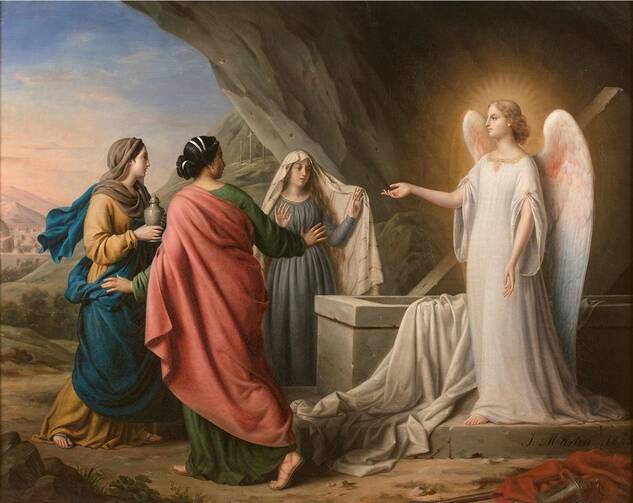Recent years have seen a renewed appreciation in theological and scriptural studies of Mary Magdalene, whom early Christian writers recognized as the “Apostle to the Apostles” and the “first witness to the resurrection.” Strangely, she had fallen into disrepute over the centuries as she came to be portrayed as a prostitute.
But whatever happened to her friend Joanna? Who ever talks about her? Who even knows about her?
History has ignored Joanna, as it has most of the other women who followed Jesus from Galilee to Jerusalem and provided for him and the Twelve “from their resources” (Lk 8:2-3). We know more about Joanna than about some of the Apostles. Yet, while we celebrate their feasts every year, we neglect her completely.
Joanna (whose name means “God has been gracious”) was the wife of Chuza, the steward of Herod Antipas. This Herod was the tetrarch of Galilee (Lk 3:1) and the son of Herod the Great, the despot whom Matthew’s infancy narratives describe as plotting to kill the child Jesus. When Herod the Great died, the Romans divided his kingdom among his three sons and his sister. Herod Antipas got Galilee.
As the steward of this vacillating puppet-king, Chuza was an influential major-domo, like the White House chief of staff but on a smaller scale. Herod probably knew Chuza’s wife, Joanna, well. That raises some intriguing questions, especially since, in Luke’s Gospel, Jesus calls Herod “a fox” (Lk 13:32), comparing him to a sneaky, unclean animal. How did Herod become so interested in John the Baptist and Jesus? Were Joanna and Chuza talking enthusiastically about them in Herod’s palace? Was Herod pumping them for information about these two popular preachers? Herod had other possible sources. He surely had spies.
Mark indicates that Herod “feared John and protected him, knowing him to be a righteous and holy man, and kept him in custody.” He adds, “When Herod heard John, he was greatly puzzled; yet he liked to listen to him” (Mk 6:20). However, he beheaded him because he didn’t want to disappoint his guests at a lavish banquet. This is one of the few New Testament episodes to which historical sources outside the Scriptures testify. Josephus, in his Antiquities, mentions it explicitly.
Luke tells us that Herod was perplexed by Jesus. He “kept trying to see him” (Lk 9:9). A friend of Herod’s, Manaen, later became a prophet and teacher in the church at Antioch (Acts 13:1); so, like Joanna, he was most likely an early disciple of Jesus. Did Manaen and Herod chat about Jesus?
Luke describes Joanna as one of the women “who had been cured of evil spirits and infirmities” (Lk 8:2). These women followed Jesus on his final journey from Galilee to Jerusalem and were present at a distance during the crucifixion (Lk 23:49). It is easy to forget that other followers witnessed Jesus’ death besides his mother and Mary Magdalene and Mary of Clopas, whom John’s Gospel highlights.
These same women from Galilee followed Joseph of Arimathea when he carried Jesus’ body away. When they located the tomb that Joseph had prepared, they returned home and prepared spices and perfumed oils to give Jesus a dignified burial (Lk 23:55-56).
It is noteworthy that Luke identifies Joanna by name as a witness to the resurrection. How did we forget that? She went back to the tomb at daybreak on the first day of the week with the other women from Galilee, bringing the spices they had prepared. Luke gives us their names: “the women were Mary Magdalene, Joanna, and Mary the mother of James” (Lk 24:10).
They found the tomb empty. Two men in dazzling garments appeared to them and said to them, “Why do you seek the living one among the dead? He is not here, but he has been raised. Remember what he said to you while he was still in Galilee: that the Son of Man must be handed over to sinners and be crucified and rise on the third day” (Lk 24:5-7). Luke tells us that the women and others who accompanied them “told this to the apostles” (Lk 24:10).
After that, Joanna was likely among the women who devoted themselves with one accord to prayer in the upper room, together with Mary the mother of Jesus and his brothers (Acts 1:14). Was she also among the 120 people who came together and cast lots to choose Judas’s successor (Acts 1:15)? Was she one of those who were “all in one place together” when “there appeared to them tongues as of fire, which parted and came to rest on each one of them,” and who were “all filled with the holy Spirit and began to speak in different tongues, as the Spirit enabled them to proclaim” (Acts 2:3-4)? Most likely.
The Orthodox tradition is kinder to Joanna than the Roman tradition is. It refers to her as “Saint Joanna the Myrrh-Bearer,” since she brought spices to Jesus’ tomb on the morning of the resurrection (Lk 24:1).
Though we often speak of the sometimes reluctant male witnesses to the resurrection, who speaks of St. Joanna and her women companions who followed Jesus from Galilee to Jerusalem? How did we forget her?








